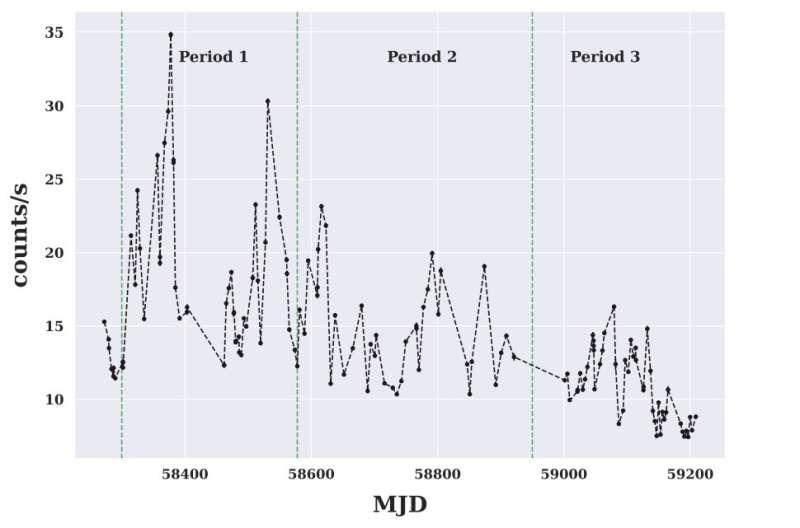May 15, 2023 report
This article has been reviewed according to Science X's editorial process and policies. Editors have highlighted the following attributes while ensuring the content's credibility:
fact-checked
preprint
trusted source
proofread
Blazar 1ES 1959+650 investigated with Swift and XMM-Newton satellites

Using NASA's Swift observatory and ESA's XMM-Newton satellite, Indian astronomers have inspected a prominent high synchrotron peaked blazar known as 1ES 1959+650. Results of the study, published May 5 on the arXiv pre-print server, shed more light on the nature of this source.
Blazars are very compact quasars associated with supermassive black holes (SMBHs) at the centers of active, giant elliptical galaxies. They belong to a larger group of active galaxies that host active galactic nuclei (AGN), and are the most numerous extragalactic gamma-ray sources. Their characteristic features are relativistic jets pointed almost exactly toward the Earth.
Based on their optical emission properties, astronomers divide blazars into two classes: flat-spectrum radio quasars (FSRQs) that feature prominent and broad optical emission lines, and BL Lacertae objects (BL Lacs), which do not. Some blazars are high synchrotron peaked (HSP) sources as their synchrotron peak is above 1,000 THz in the rest frame. Observations show that particles are efficiently accelerated up to very high energies (VHEs) in the jets of HSPs, which makes such sources very interesting for astronomers studying extreme blazars.
At a redshift of approximately 0.048, 1ES 1959+650 is a prominent nearby HSP blazar in which the synchrotron peak of the spectral energy distribution (SED) appears in the ultraviolet/X-ray band. It exhibits strong flux variability in optical, X-ray and TeV energy bands and has experienced an unprecedented X-ray flaring activity between August 2015 and January 2016.
Recently, a team of astronomers led by Kiran A. Wani of the Aryabhatta Research Institute of Observational Sciences (ARIES) in India, has analyzed Swift and XMM-Newton observations of 1ES 1959+650, with the main aim of investigating the temporal and spectral variability of this blazar on timescales from minutes to years covering different flux states.
"Swift-XRT and XMM–Newton EPIC-pn observations have been used to study the HSP 1ES 1959+650 during the period June 2018–December 2020 in total 127 nights of observations," the researchers wrote in the paper.
The study detected significant variability of 1ES 1959+650 in seven of the observing nights with flux variability amplitude varying between 1.95% and 3.12%. The flux doubling timescale was found to be some 15,270 seconds and the black hole mass was calculated to be about 295 million solar masses.
The observations show that 1ES 1959+650 exhibits log-normality behavior on long-term timescales. The astronomers assume that such behavior could be attributed to minijets-in-a-jet model or could be due to the propagation of relativistic shocks down the blazar's jet.
The research also found that on the long timescales, 1ES 1959+650 showed high as well as low flux states. Moreover, the hardness ratio analysis on long term timescales indicates that the blazar follows the so-called "harder-when-brighter" trend.
The astronomers also managed to estimate the magnetic field strength of the emitting region in 1ES 1959+650—which was found to be approximately 0.64 Gauss. This is consistent with previous results.
More information: Kiran A Wani et al, X-ray Studies of Blazar 1ES 1959+650 Using SWIFT & XMM-NEWTON Satellite, arXiv (2023). DOI: 10.48550/arxiv.2305.03246
Journal information: arXiv
© 2023 Science X Network




















